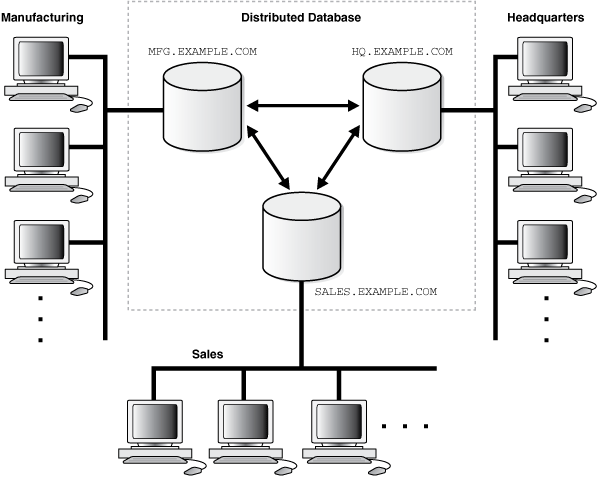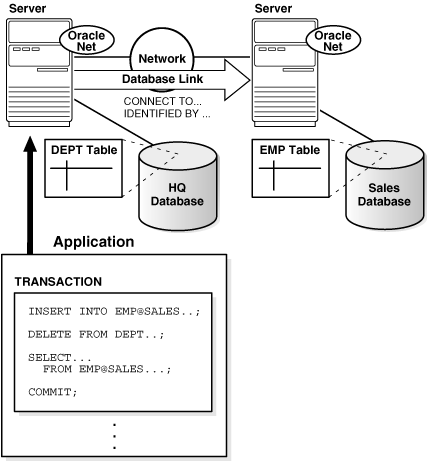| Oracle® Database Administrator's Guide 11g Release 2 (11.2) Part Number E25494-02 |
|
|
PDF · Mobi · ePub |
| Oracle® Database Administrator's Guide 11g Release 2 (11.2) Part Number E25494-02 |
|
|
PDF · Mobi · ePub |
A distributed database system allows applications to access data from local and remote databases. In a homogenous distributed database system, each database is an Oracle Database. In a heterogeneous distributed database system, at least one of the databases is not an Oracle Database. Distributed databases use a client/server architecture to process information requests.
This section contains the following topics:
A homogenous distributed database system is a network of two or more Oracle Databases that reside on one or more systems. Figure 31-1 illustrates a distributed system that connects three databases: hq, mfg, and sales. An application can simultaneously access or modify the data in several databases in a single distributed environment. For example, a single query from a Manufacturing client on local database mfg can retrieve joined data from the products table on the local database and the dept table on the remote hq database.
For a client application, the location and platform of the databases are transparent. You can also create synonyms for remote objects in the distributed system so that users can access them with the same syntax as local objects. For example, if you are connected to database mfg but want to access data on database hq, creating a synonym on mfg for the remote dept table enables you to issue this query:
SELECT * FROM dept;
In this way, a distributed system gives the appearance of native data access. Users on mfg do not have to know that the data they access resides on remote databases.
Figure 31-1 Homogeneous Distributed Database

An Oracle Database distributed database system can incorporate Oracle Databases of different versions. All supported releases of Oracle Database can participate in a distributed database system. Nevertheless, the applications that work with the distributed database must understand the functionality that is available at each node in the system. A distributed database application cannot expect an Oracle7 database to understand the SQL extensions that are only available with Oracle Database.
The terms distributed database and distributed processing are closely related, yet have distinct meanings. There definitions are as follows:
Distributed database
A set of databases in a distributed system that can appear to applications as a single data source.
Distributed processing
The operations that occurs when an application distributes its tasks among different computers in a network. For example, a database application typically distributes front-end presentation tasks to client computers and allows a back-end database server to manage shared access to a database. Consequently, a distributed database application processing system is more commonly referred to as a client/server database application system.
Distributed database systems employ a distributed processing architecture. For example, an Oracle Database server acts as a client when it requests data that another Oracle Database server manages.
The terms distributed database system and database replication are related, yet distinct. In a pure (that is, not replicated) distributed database, the system manages a single copy of all data and supporting database objects. Typically, distributed database applications use distributed transactions to access both local and remote data and modify the global database in real-time.
Note:
This book discusses only pure distributed databases.The term replication refers to the operation of copying and maintaining database objects in multiple databases belonging to a distributed system. While replication relies on distributed database technology, database replication offers applications benefits that are not possible within a pure distributed database environment.
Most commonly, replication is used to improve local database performance and protect the availability of applications because alternate data access options exist. For example, an application may normally access a local database rather than a remote server to minimize network traffic and achieve maximum performance. Furthermore, the application can continue to function if the local server experiences a failure, but other servers with replicated data remain accessible.
See Also:
Oracle Database Advanced Replication for more information about Oracle Database replication features
Oracle Streams Concepts and Administration for information about Oracle Streams, another method of sharing information between databases
In a heterogeneous distributed database system, at least one of the databases is a non-Oracle Database system. To the application, the heterogeneous distributed database system appears as a single, local, Oracle Database. The local Oracle Database server hides the distribution and heterogeneity of the data.
The Oracle Database server accesses the non-Oracle Database system using Oracle Heterogeneous Services with an agent. If you access the non-Oracle Database data store using an Oracle Transparent Gateway, then the agent is a system-specific application. For example, if you include a Sybase database in an Oracle Database distributed system, then you must obtain a Sybase-specific transparent gateway so that the Oracle Database in the system can communicate with it.
Alternatively, you can use generic connectivity to access non-Oracle Database data stores so long as the non-Oracle Database system supports the ODBC or OLE DB protocols.
Note:
Other than the introductory material presented in this chapter, this book does not discuss Oracle Heterogeneous Services. See Oracle Database Heterogeneous Connectivity User's Guide for more detailed information about Heterogeneous Services.Heterogeneous Services (HS) is an integrated component within the Oracle Database server and the enabling technology for the current suite of Oracle Transparent Gateway products. HS provides the common architecture and administration mechanisms for Oracle Database gateway products and other heterogeneous access facilities. Also, it provides upwardly compatible functionality for users of most of the earlier Oracle Transparent Gateway releases.
For each non-Oracle Database system that you access, Heterogeneous Services can use a transparent gateway agent to interface with the specified non-Oracle Database system. The agent is specific to the non-Oracle Database system, so each type of system requires a different agent.
The transparent gateway agent facilitates communication between Oracle Database and non-Oracle Database systems and uses the Heterogeneous Services component in the Oracle Database server. The agent executes SQL and transactional requests at the non-Oracle Database system on behalf of the Oracle Database server.
See Also:
Your Oracle-supplied gateway-specific documentation for information about transparent gatewaysGeneric connectivity enables you to connect to non-Oracle Database data stores by using either a Heterogeneous Services ODBC agent or a Heterogeneous Services OLE DB agent. Both are included with your Oracle product as a standard feature. Any data source compatible with the ODBC or OLE DB standards can be accessed using a generic connectivity agent.
The advantage to generic connectivity is that it may not be required for you to purchase and configure a separate system-specific agent. You use an ODBC or OLE DB driver that can interface with the agent. However, some data access features are only available with transparent gateway agents.
A database server is the Oracle software managing a database, and a client is an application that requests information from a server. Each computer in a network is a node that can host one or more databases. Each node in a distributed database system can act as a client, a server, or both, depending on the situation.
In Figure 31-2, the host for the hq database is acting as a database server when a statement is issued against its local data (for example, the second statement in each transaction issues a statement against the local dept table), but is acting as a client when it issues a statement against remote data (for example, the first statement in each transaction is issued against the remote table emp in the sales database).
Figure 31-2 An Oracle Database Distributed Database System

A client can connect directly or indirectly to a database server. A direct connection occurs when a client connects to a server and accesses information from a database contained on that server. For example, if you connect to the hq database and access the dept table on this database as in Figure 31-2, you can issue the following:
SELECT * FROM dept;
This query is direct because you are not accessing an object on a remote database.
In contrast, an indirect connection occurs when a client connects to a server and then accesses information contained in a database on a different server. For example, if you connect to the hq database but access the emp table on the remote sales database as in Figure 31-2, you can issue the following:
SELECT * FROM emp@sales;
This query is indirect because the object you are accessing is not on the database to which you are directly connected.